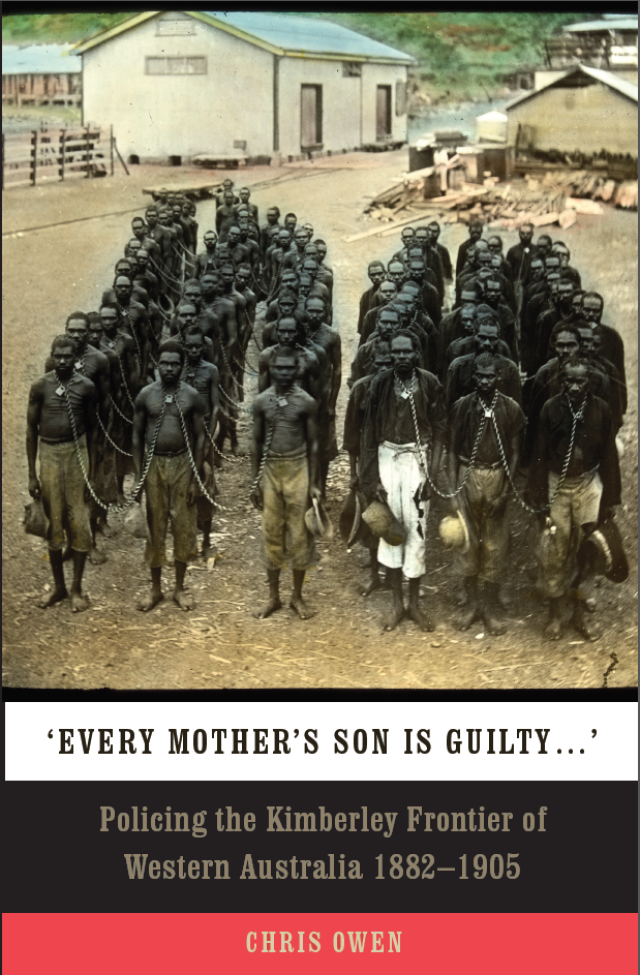
Every Mother’s Son is Guilty: Policing the Kimberley Frontier of Western Australia 1882–1905
Chris Owen
UWA Publishing, 2016
640 pp, $50.
Chris Owen has produced an exhaustive history of colonial Western Australia pastoralists and the police who served their interests in the Kimberley region. It shows that, at best, they considered Aboriginal people as convenient slave labour and at worst pests who were to be exterminated.
The squatters who colonised the area often established their herds by stealing cattle from their neighbours. This went without any response; it seems to have been regarded as just part of the rough and tumble of doing business in the area.
However, if Aboriginal people speared cattle for food — which they did increasingly as native fauna were displaced — the pastoralists responded with violent fury. Flour laced with arsenic was given as a “gift” and the bodies burned afterwards to hide the evidence.
Not only did the station owners murder the local peoples whose land they had stolen, they demanded the police do the same. Before WA became self-governing in 1890, the pastoralists did not have it all their own way. But after self-government, they dominated the legislature in Perth via a gerrymander and their thundering demands were met with compliance.
While primarily focussing on the police, Owen also narrates the development of the rich dynasties that still dominate WA’s economy and politics. There were many shady dealings in establishing the family fortunes.
For instance, in 1879, Alexander Forrest explored areas of the Kimberley and got himself appointed as the government land agent for parcelling out leases. He tied up 21 million hectares for himself.
The pastoralists used Aboriginal workers during the dry season, providing them with some food and clothing — but no pay. The workers were expected to fend for themselves during the wet season.
Some station owners branded their workers in the same way as their cattle. If workers left a station, the owners expected the police to force them back to work. When stations were sold, Aboriginal slaves were listed along with cattle and fences as part of the establishment. Their ownership of their land, however, was never recognised.
The small number of police officers scattered through the Kimberley reported regularly and at length to the commissioner in Perth. Owen has trawled through their reports and found extensive evidence of mass murder.
The standard police technique was to go on long distance horseback patrols employing “native assistants” to track bands of Aboriginal people. Footprints near the site of a dead bullock were sufficient evidence of guilt.
Aboriginal groups would be followed and at dawn the police would ambush the sleeping band. Any sign of self-defence was “resisting arrest” and warranted death. Anyone fleeing could be shot. This was referred to as “dispersing” the Aboriginal inhabitants.
Survivors were rounded up – including children as young as ten – chained together at the neck and marched up to 400 kilometres to court. At night during the forced march the prisoners would be further chained by the ankle and attached to a tree.
Aboriginal women were not arrested but were dragged into the forced marches as “witnesses” and raped by police along the way.
Court proceedings were farcical. Often the Justice of the Peace would be the property owner complaining of stock losses. Three-year jail sentences were common, often accompanied by whipping — and neck chains were inflicted for the entire sentence.
Kimberley jails were just corrugated iron shanties in which temperatures would reach over 40oC. At night, ankle chains would be added and secured to ring bolts in the floor.
Owen demonstrates that it took a particular kind of person to perform “dispersals”. The authorities in Perth often had to cull officers not suited to the role.
For example, Sergeant Lavery of Wyndham was disciplined when his superior reported to headquarters that Lavery “could not shoot a nigger in cold blood”, despite direct orders to do so.
The report that produced the disciplinary action on Lavery was titled: “Expedition to Disperse Natives on King River — December 1892. Failure from Serg Lavery to Shoot Natives Defeated the Purpose of the Trip.”
In 1894, a guerrilla resistance flared up led by Jandamarra, a Bunuba warrior. Jandamarra had been employed as a “native assistant”, but became alarmed when he was forced to help arrest his own relatives.
However, he acquired an understanding of the police methods and was a brilliant rifle shot. Where other Aboriginal warriors only used spears, Jandamarra used stolen rifles and manufactured his own bullets.
He defied all police efforts to capture him for three years. However, the authorities took vengeance on any other Aboriginal people they could find. The 1890s are still known as “the killing times” in Aboriginal oral history.
After federation, pressure mounted on the WA state government to stop the mayhem in the Kimberley. Royal Commissioner Walter Roth was given the task of finding the truth of what had occurred in the region. He was met with a wall of silence among white residents, and only interviewed two Aboriginal people.
Roth chose not to look into what had taken place before 1900, thus excluding the worst of the violence. But what he found was damning enough.
The police were operating nearly completely outside the law and the rules of evidence were simply not applied. Aboriginal prisoners always pleaded guilty, because they could not understand a word of what was being said in court.
Despite its weaknesses, the report caused a sensation and forced changes in police behaviour. The changes were not to the satisfaction of the Kimberley colonists.
As Charles Annear, the telegraph operator in the upper Fitzroy River area put it, the increased “leniency” meant “it will take years to again get the natives under”.
[You can read the introduction to Chris Owen’s book at Links International Journal of Socialist Renewal.]
Like the article? Subscribe to Green Left now! You can also like us on Facebook and follow us on Twitter.